I'm doing a "Circle View"(Bird View) system for a long truck. Due to the fact that the car is long on the sides of one camera is not enough. I decided to try to put two cameras and sew them, but there is a drawback. the code that I use stitches the image is not quite even and the joint is visible. How can I change the code to make the joint was less visible and sewn better? A chessboard with a size of 4x6. It stands in the middle of two video cameras. Maybe there's a way to stitch on a checkerboard?
Here's my stitching result:

Here are two images to be stitched together:
The code I have now:
import cv2 as cv
import numpy as np
def FindHomography(Matches, BaseImage_kp, SecImage_kp):
# If less than 4 matches found, exit the code.
if len(Matches) < 4:
print("\nNot enough matches found between the images.\n")
exit(0)
# Storing coordinates of points corresponding to the matches found in both the images
BaseImage_pts = []
SecImage_pts = []
for Match in Matches:
BaseImage_pts.append(BaseImage_kp[Match[0].queryIdx].pt)
SecImage_pts.append(SecImage_kp[Match[0].trainIdx].pt)
# Changing the datatype to "float32" for finding homography
BaseImage_pts = np.float32(BaseImage_pts)
SecImage_pts = np.float32(SecImage_pts)
# Finding the homography matrix(transformation matrix).
(HomographyMatrix, Status) = cv.findHomography(SecImage_pts, BaseImage_pts, cv.RANSAC, 4.0)
return HomographyMatrix, Status
def GetNewFrameSizeAndMatrix(HomographyMatrix, Sec_ImageShape, Base_ImageShape):
# Reading the size of the image
(Height, Width) = Sec_ImageShape
# Taking the matrix of initial coordinates of the corners of the secondary image
# Stored in the following format: [[x1, x2, x3, x4], [y1, y2, y3, y4], [1, 1, 1, 1]]
# Where (xi, yi) is the coordinate of the i th corner of the image.
InitialMatrix = np.array([[0, Width - 1, Width - 1, 0],
[0, 0, Height - 1, Height - 1],
[1, 1, 1, 1]])
# Finding the final coordinates of the corners of the image after transformation.
# NOTE: Here, the coordinates of the corners of the frame may go out of the
# frame(negative values). We will correct this afterwards by updating the
# homography matrix accordingly.
FinalMatrix = np.dot(HomographyMatrix, InitialMatrix)
[x, y, c] = FinalMatrix
x = np.divide(x, c)
y = np.divide(y, c)
# Finding the dimentions of the stitched image frame and the "Correction" factor
min_x, max_x = int(round(min(x))), int(round(max(x)))
min_y, max_y = int(round(min(y))), int(round(max(y)))
New_Width = max_x
New_Height = max_y
Correction = [0, 0]
if min_x < 0:
New_Width -= min_x
Correction[0] = abs(min_x)
if min_y < 0:
New_Height -= min_y
Correction[1] = abs(min_y)
# Again correcting New_Width and New_Height
# Helpful when secondary image is overlaped on the left hand side of the Base image.
if New_Width < Base_ImageShape[1] + Correction[0]:
New_Width = Base_ImageShape[1] + Correction[0]
if New_Height < Base_ImageShape[0] + Correction[1]:
New_Height = Base_ImageShape[0] + Correction[1]
# Finding the coordinates of the corners of the image if they all were within the frame.
x = np.add(x, Correction[0])
y = np.add(y, Correction[1])
OldInitialPoints = np.float32([[0, 0],
[Width - 1, 0],
[Width - 1, Height - 1],
[0, Height - 1]])
NewFinalPonts = np.float32(np.array([x, y]).transpose())
# Updating the homography matrix. Done so that now the secondary image completely
# lies inside the frame
HomographyMatrix = cv.getPerspectiveTransform(OldInitialPoints, NewFinalPonts)
return [New_Height, New_Width], Correction, HomographyMatrix
ratio_thresh = 0.9
image1 = cv.imread(filename='/home/msi-user/PycharmProjects/170Camera/1_camera.jpg')
image2 = cv.imread(filename='/home/msi-user/PycharmProjects/170Camera/2_camera.jpg')
# -----------------------------------------KAZE--------------------------------#
AKAZE = cv.KAZE_create() # KAZE, AKAZE, ORB, BRISK, xfeatures2d.SURF
keypoints1, descriptors1 = AKAZE.detectAndCompute(image1, None)
keypoints2, descriptors2 = AKAZE.detectAndCompute(image2, None)
FLANN_INDEX_KDTREE = 1
index_params = dict(algorithm=FLANN_INDEX_KDTREE, trees=5)
search_params = dict(checks=50)
descriptors1 = np.float32(descriptors1)
descriptors2 = np.float32(descriptors2)
FLANN = cv.FlannBasedMatcher(indexParams=index_params,
searchParams=search_params)
matches = FLANN.knnMatch(queryDescriptors=descriptors1,
trainDescriptors=descriptors2,
k=2)
good_matches = []
t = []
for m, n in matches:
if m.distance < ratio_thresh * n.distance:
good_matches.append([m])
t.append(m)
output = cv.drawMatches(img1=image1,
keypoints1=keypoints1,
img2=image2,
keypoints2=keypoints2,
matches1to2=t,
outImg=None,
flags=cv.DrawMatchesFlags_NOT_DRAW_SINGLE_POINTS)
cv.namedWindow("drawMatches.jpg", cv.WINDOW_NORMAL)
cv.imshow("drawMatches.jpg", output)
# ----------------------------------FindHomography-------------------------------------------#
HomographyMatrix, Status = FindHomography(good_matches, keypoints1, keypoints2)
BaseImage = image1
SecImage = image2
NewFrameSize, Correction, HomographyMatrix = GetNewFrameSizeAndMatrix(HomographyMatrix, SecImage.shape[:2],
BaseImage.shape[:2])
StitchedImage = cv.warpPerspective(SecImage, HomographyMatrix, (NewFrameSize[1], NewFrameSize[0]))
StitchedImage[Correction[1]:Correction[1] + BaseImage.shape[0],
Correction[0]:Correction[0] + BaseImage.shape[1]] = BaseImage
cv.namedWindow("stisched2.jpg", cv.WINDOW_NORMAL)
cv.imshow("stisched2.jpg", StitchedImage)
cv.imwrite("result.jpg", StitchedImage)
while True:
if cv.waitKey(1) == 27:
break

